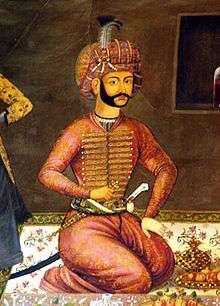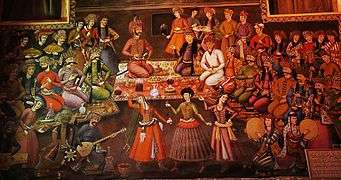Abbas II of Persia
| Shah Abbas II | |
|---|---|
| Shahanshah of Persia, Sahib-i-Qiran, Sultan bar Salatin | |
 Shah Abbas II | |
| Reign | 15 May 1642 – 26 October 1666 |
| Coronation | 15 May 1642 |
| Predecessor | Safi I |
| Successor | Suleiman I |
| Born |
31 December 1632 Qazvin |
| Died |
25 or 26 October 1666 Khusrauabad, near Damghan |
| Burial | Qom |
| House | Safavid dynasty |
| Father | Safi I |
| Mother | Anna Khanum |
Sultan Muhammad Mirza (also spelled Soltan Mohammad Mirza; 31 December 1632[1] – 25/26 October 1666), better known by his dynastic name of Shah Abbas II (Persian: شاه عباس دوم), was the seventh Safavid king (shah) of Iran, ruling from 1642 to 1666.
Early life
Abbas II was born in Qazvin with the name of Sultan Muhammad Mirza.[2][3] He was the son of Shah Safi I and a Circassian, Anna Khanum.[4] He was the oldest of five brothers. Not much is known about Muhammad Mirza's youth, except that he spent his youth in the Safavid harem, and was tutored by his mentor Rajab Ali Tabrizi.[2] He also learned how to maintain order over a state and other royal matters by two other nobles named Muhammad-Ali Beg and Jani Khan Shamlu.
Reign
On 15 May 1642, at Kashan, Muhammad Mirza was crowned as shah of Iran and chose "Abbas II" as his dynastic name. Since he was less than ten years old when he became shah, the job of governing Persia was placed in the hands of his mother, Anna Khanum, and the grand vizier, Saru Taqi, while Abbas concentrated on his education at Qazvin. Anna Khanum and Saru Taqi worked closely together, and under them Iran was in secure hands. The French traveller Jean Chardin noted their close working relationship, saying:
| “ | The power of mothers of Persian kings looms large when they [shahs] are at a young age. Abbas II's mother had much influence, which was absolute. She [the queen mother] was in close contact with the prime minister and they would help each other. Saru Taqi was the agent and confidant of the queen mother; he would gather immense fortunes for her. She governed Persia at her will through her minister.[1] | ” |

After one year had passed, Abbas II moved to the Safavid capital of Isfahan. During the same year, the powerful general Rustam Khan, refused to obey Safavid orders, and marched towards Isfahan to depose Abbas II. However, Saru Taqi managed to have him killed at Mashhad.[5]
In 1644, some Bakhtiari tribes rebelled against Abbas II. The rebellion, however, was quickly suppressed by Saru Taqi.
Saru Taqi led a drive against corruption and, as a result, made many enemies. On 11 October 1645 he was assassinated by a group of army officers. He was succeeded by Khalifa Sultan, who held the office of grand vizier until his death in 1653 or 1654.
Unlike his father, Abbas II took an active interest in government and military matters once he began to rule for himself (probably around age 15). In the summer of 1648, Abbas II, who sought to recapture Kandahar from the Mughal Empire, marched from Isfahan with an army of 40,000 men and after capturing Bost, he laid siege to Kandahar and captured it after a brief siege on 22 February 1649.[6][7] Abbas II then appointed the Georgian ghulam ("military slave") Mihrab Khan as the governor of the city.[6] The Mughals attempted to retake the city in 1651 but the arrival of winter forced them to suspend the siege.[6]
The Mughal ruler Shah Jahan then sent his son Aurangzeb with an army of 50,000 soldiers to recapture Kandahar. Although Aurangzeb defeated Abbas II outside the city, he was unable to take it.[8] His artillery train proved not up to the task.[9] Aurangzeb attempted to take the fortress city again in 1652. In the meantime, Abdul Aziz, the Uzbek ruler of Bukhara, had entered into an alliance with Abbas II, and in May 1652, he dispatched 10,000 troops to Kabul to harass the Mughal supply lines.[10] Though not strong enough to lift the siege, the Uzbek threatened a Mughal convoy of 2,000 troops who were escorting one and a half million silver coins to the besieger's army at Kandahar.[10] After two months of fighting Safavid resistance,[9] along with the growing activities of the Uzbeks,[6] Aurangzeb was forced to abandon the campaign. In 1653, the Mughals tried to take it once again, but failed doing so. The city would subsequently remain in Safavid hands until its fall in 1736.[9]
In 1651, in order to increase Iranian influence in the North Caucasus, Safavid troops attacked Russian fortifications in the region at the Sunzha, which eventually culminated into the Russo-Persian War (1651–53). The Safavid influence prior to the war extended to the feudal tenure of the Kumyks in Dagestan. After two successful years, the plans were to capture the city of Terek and to move all the way to Astrakhan. Soon however, another conflict on the war's eastern front had started. At the same time, the Russian government sent an embassy, led by courtier Prince Ivan Lobanov-Rostovsky and steward Ivan Komynin, to Isfahan to seek a peaceful settlement of the conflict. Abbas II agreed with the settlement offer as he wanted to settle the issue in the far eastern territories first. The war ended with no further territorial gains, but the Safavids manage to increase their influence in the North Caucasus.
In 1654, Abbas II appointed the Georgian prince Vakhtang V as the ruler of Georgia. In 1656, the people of Isfahan rebelled against Parsadan Gorgijanidze, who was the prefect of the city. Abbas II quickly had Parsadan removed from the office and appointed him as the Master of ceremonies of the Safavid court.
In 1659, the Kingdom of Kakheti rose up against the Safavid Iranian rule due to a change of policy that included the settling of Qizilbash Turkic tribes in the region in order to repopulate the province, after Shah Abbas' mass deportations of between 130,000[11] - 200,000[12] Georgian subjects to Persia's heartlands and massacre of another thousand in 1616 left the province substantially underpopulated. This Bakhtrioni Uprising was successfully defeated under the personal direction of Shah Abbas II. However, strategically it remained inconclusive.[13] Iranian authority was restored in Kakheti, but the Qizilbash Turkics were prevented from settling in Kakheti.
Abbas II's reign was relatively peaceful and was significant for being free of any Ottoman attack. Abbas II, like his great-grandfather Abbas I, was famous for the construction of many buildings, such as the famous Chehel Sotoun in Isfahan.[2] He died in Khusrauabad near Damghan on the night of 25–26 October 1666, and was buried alongside his father in Qom.[14][15] He was succeeded by his son Suleiman I. He also had sons named Hamza Mirza, Ismail Mirza and Mirza Ali Naqi, and had two daughters.[16]
Issue
Abbas II married several times;
- m. Naqiyat (or Nakihat) Khanum, a Circassian lady.
- m. Nur un-nisa Khanum, a Georgian lady.
- m. 1660, Princess Anouka (m. second, 1668 (div. 1695), Shah Verdi Khan of Luristan, and d. 1697), daughter of Vakhtang V [Shah Nawaz Khan II], King of Kartli, by his first wife, Queen Rwadam, daughter of Prince Qaphlan Baratashvili-Orbeliani.
References
- 1 2 Babaie et al. 2004, p. 44
- 1 2 3 Savory 1985, p. 76
- ↑ Roemer 1986, p. 288.
- ↑ Newman 2008, p. 81.
- ↑ Roemer 1986, p. 292.
- 1 2 3 4 Matthee & Mashita 1985
- ↑ Roemer 1986, pp. 299–300.
- ↑ Chandra 2005, p. 228.
- 1 2 3 Kohn 2007, p. 338.
- 1 2 Burton 1997, p. 266.
- ↑ Munshī 1978, p. 1116
- ↑ Sīstānī, p. 509
- ↑ Javakhishvili 1970
- ↑ Roemer 1986, p. 301.
- ↑ Babaie et al. 2004, p. 105.
- ↑ Buyers, Christopher. "PERSIA - The Safavid Dynasty (Genealogy)". Retrieved 1 December 2015.
Sources
- Babaie, Sussan; Babayan, Kathryn; McCabe, Ina Baghdiantz; Farhad, Massumeh (2004). Slaves of the Shah: New Elites of Safavid Iran. London, UK: I. B. Tauris. pp. 1–218. ISBN 1-86064-721-9. LCCN 2005272298.
- Burton, Audrey (1997). The Bukharans: A Dynastic, Diplomatic, and Commercial History, 1550–1702. New York, NY: St. Martin's Press. ISBN 0-312-17387-3. LCCN 97012314.
- Chandra, Satish (2005). Medieval India: from Sultanat to the Mughals. II: Mughal Empire, 1526–1748. New Delhi, India: Har-Anand Publications. ISBN 81-241-0605-3. LCCN 97901412.
- Javakhishvili, I. (1970). "Essays of Georgian History, Part IV" (PDF). Batumi Art Teaching University (in Georgian). Tbilisi, Georgia: Soviet Georgia Publishing. pp. 230–233. Archived (PDF) from the original on 17 May 2015. Retrieved May 17, 2015.[source needs translation]
- Kohn, George Childs, ed. (2007). Dictionary of Wars. Infobase Publishing. ISBN 0-8160-6577-2. LCCN 2005058936.
- Matthee, Rudi; Mashita, Hiroyuki (1985). Yarshater, Ehsan, ed. Kandahar IV: From The Mongol Invasion Through the Safavid Era. Routledge & Kegan Paul. Archived from the original on 11 September 2014. Retrieved 11 September 2014.
- Munshī, Iskandar (1978). The History of Shah 'Abbas the Great. II. Translated by Savory, Roger M. Boulder, CO: Westview Press. ISBN 0-89158-296-7. LCCN 78020663.
- Newman, Andrew J. (2008). Safavid Iran: Rebirth of a Persian Empire. London, UK: I. B. Tauris. pp. 1–281. ISBN 1-84511-830-8.
- Roemer, H. R. (1986). "The Safavid period". The Cambridge History of Iran. 6: The Timurid and Safavid periods. Cambridge, UK: Cambridge University Press. pp. 189–351. ISBN 0-521-20094-6.
- Savory, R. M. (1985). "ʿAbbās (II)". In Yarshater, Ehsan. Encyclopaedia Iranica. I. Routledge & Kegan Paul. p. 76. ISBN 0-7100-9099-4. LCCN 84673402.
| Abbas II of Persia | ||
| Preceded by Shah Safi |
Shah of Persia 1642–1666 |
Succeeded by Suleiman I |